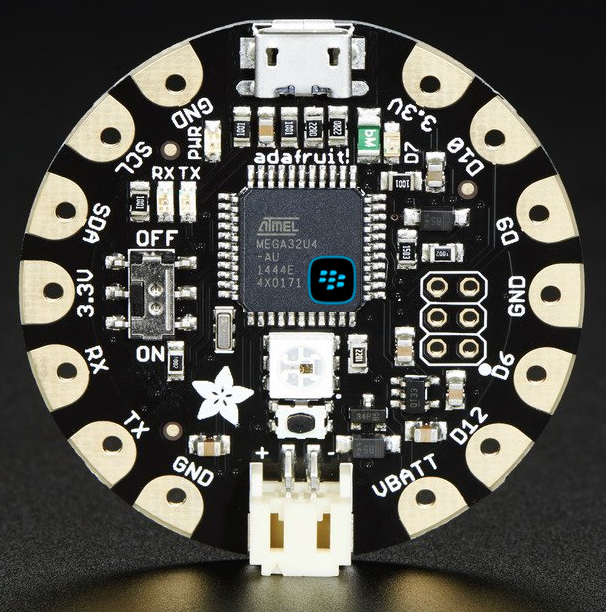So far I have talked about a smart watch and band, two items that are fairly straight forward on their functionality and how they are used. The other side of smart wearables are those with flexible usability. This market, as far as I can tell, is mainly in the DIY segment. Being mostly DIY makes it hard to sell to the mass consumers, as it is not simple to put a finger on what it is or what the use would be for more than the individual who created that one item for their specific use. Luckily, there is room for standardization of a product by using components provided by Adafruit.
What a great reason to start a company. Adafruit has a nice sized inventory of products to get you started in your electronic DIY adventures. The thing that drove me first to the site was the Flora, a platform that is Arduino compatible. Arduino being your starting point for your crazy electronic and software DIY mad scientist experiments. I don’t remember what exactly drove me to finding the Flora, but it was probably when I was interested in fiber optic clothing or some other project of combining LEDs with clothing. Whatever the crazy brain experiment was, I ended up on the Flora site, which was started from LilyPad. Being that the purpose of Flora/LilyPad is a foundation for garment electrification, the uses are endless. There is even a smaller version now, called the GEMMA, which is barely larger than a quarter. Once you have the platform connected, then you can easily add things like LEDs, like the NeoPixel. But, don’t stop there, you can add GPS units, accelerometer and compass, gyroscope and magnetometer, pulse sensors and light sensors. Added functionality can be attained with BlueTooth and pressure sensing or conductive fabrics. Sew in your solar charger and battery pack and you are set to be mobile.
So, how does this help BlackBerry? Well, BlackBerry doesn’t need to acquire Adafruit. I don’t think Adafruit would want to be acquired by any other fruit company. But, BlackBerry could partner with Adafruit to provide a Flora type platform with a direct connection to BB10 through invocation framework. BlackBerry wouldn’t even have to use Flora, if they made a QNX version. But, to make life easier and increase the possibility of people adopting BlackBerry Wearables, the best bet would be to just modify the Flora to be BB10 compatible. Since there are already projects for Flora and other accessories, it could be possible that something made for a standard Flora could be easily adapted to a BlackBerry Flora.

Where does BlackBerry go from there? Beyond letting DIYers do their magic, BlackBerry could work on products it could sell, instead of making an Instructable. Since BlackBerry’s current focus is the health field, there are plenty of uses for smart wearables that would connect to BES or a BlackBerry 10 device. Instead of just relying on wired connections, BlackBerry (or a partner) could develop smart hospital gowns to feed data to QNX based health monitors that are connected through the HBox. It doesn’t even have to be the full gown, but instead of sticky pads and wires, it could be a spandex like shirt that would snuggly keep the sensors attached and be more comfortable for the patient. From there, that technology could be used to monitor other people, like firefighters or emergency responders. A part of their uniform could be like long underwear to track body heat and other health levels and send that information back to the fire truck or command center. GPS and movement sensors could be added to keep track of them while they were in a burning house or a low visibility rescue. This same technology could be applied to the military. Commanders could be fed the health of their soldiers in real time. In the consumer market, athletes, both professional and amateur, could use the technology to monitor their own progress straight to their phone. Instead of having one band that guesses at your movements, you could have an entire smart outfit that knows how you are doing and if you are achieving your goals.
Another use for this technology could be back to the basic notifications that you would have on the watch or band. For those who don’t want to wear the smart wrist item, the smart notifications could be in a shirt or a jacket. It could be simply a magnet pin attachment or snapped on like a button. With the right setup, you could make a French Cuff with built in cufflinks that had LED lights (or even stand-alone cufflinks). When you had a notification, you could get a buzz on the cuff and a blink of the LED. If you setup your notifications to be color coded, you could determine if the message was important enough by the color. Having not interrupted your dinner, movie or play with a loud phone ring or vibration, you can determine if you need to step aside and view the message. Unless of course, your jacket had flexible OLED display sewn into the inside of your jacket to quickly view the message.
The possibilities are endless, but first the connection has to be there to make it worth while for the developers to venture down that road. BlackBerry wants to be the securer of the IoT, it doesn’t mean that they can’t also be the builder of the IoT. The wearbles market is still trying to figure out what it is going to be. It isn’t even close to being mainstream yet, so it is a good time to jump in and help guide its progress.
About DeanLogic
Dean has been playing around with programming ever since his family got an IBM PC back in the early 80's. Things have changed since BASICA and Dean has dabbled in HTML, JavaScript, Action Script, Flex, Flash, PHP, C#, C++, J2ME and SQL. On this site Dean likes to share his adventures in coding. And since programming isn't enough of a time killer, Dean has also picked up the hobby of short film creation.

